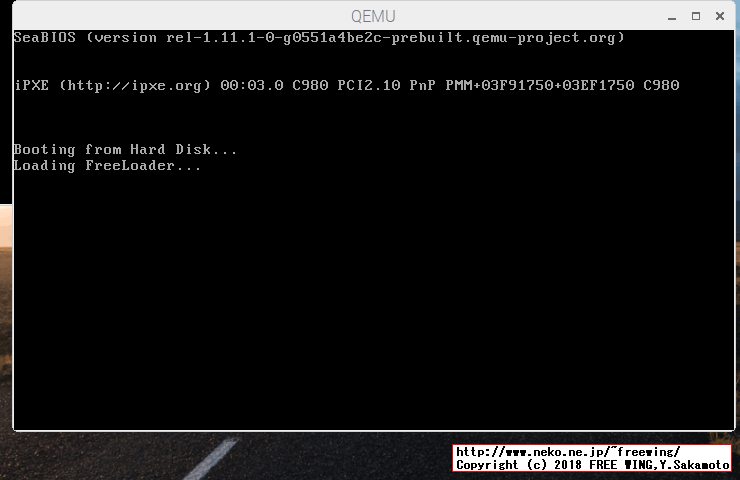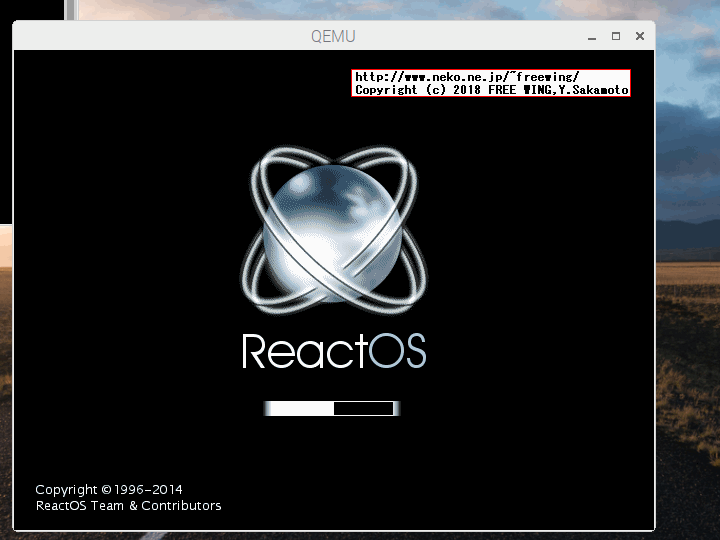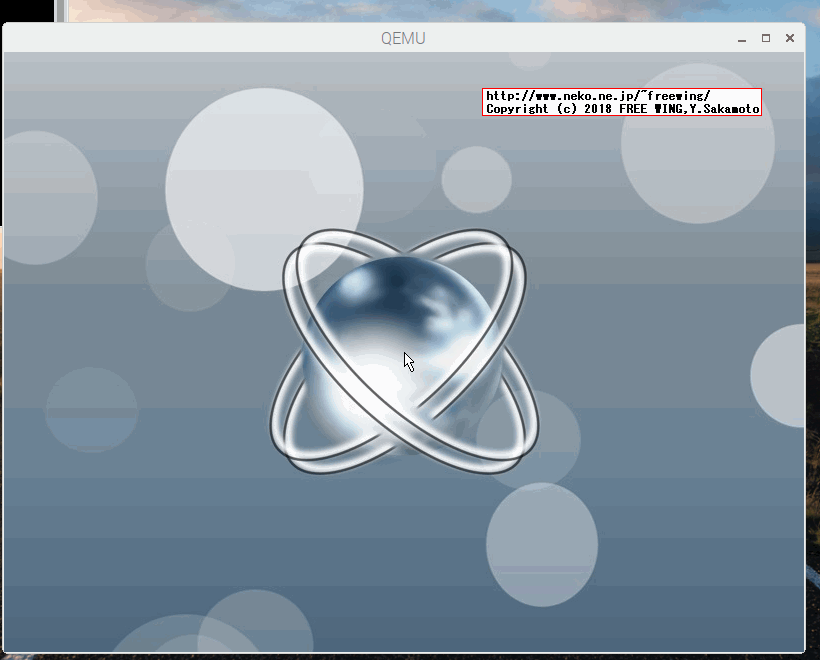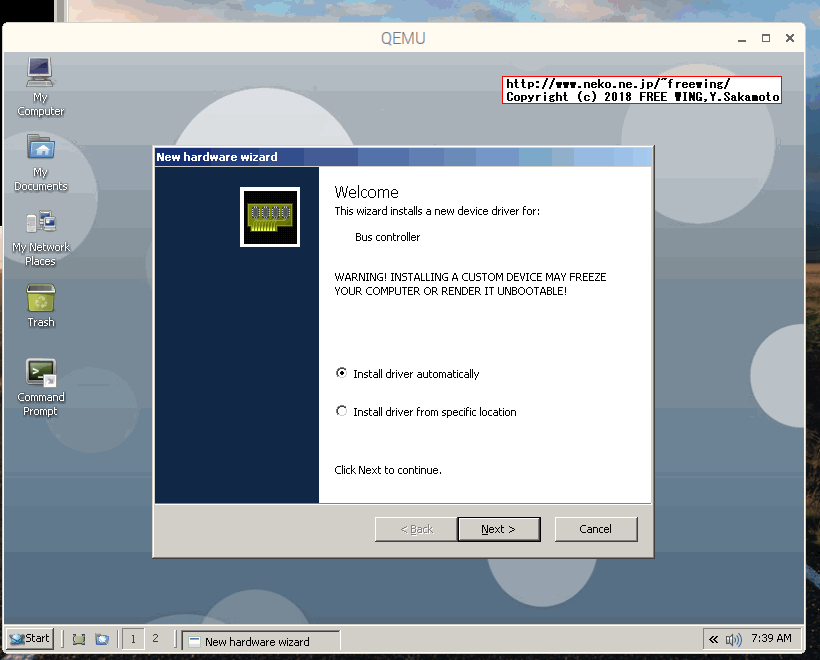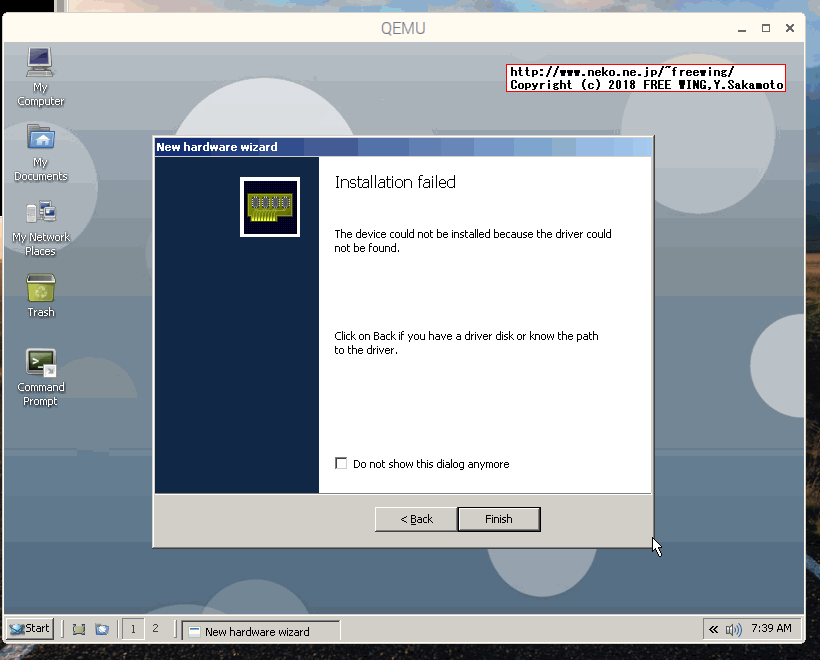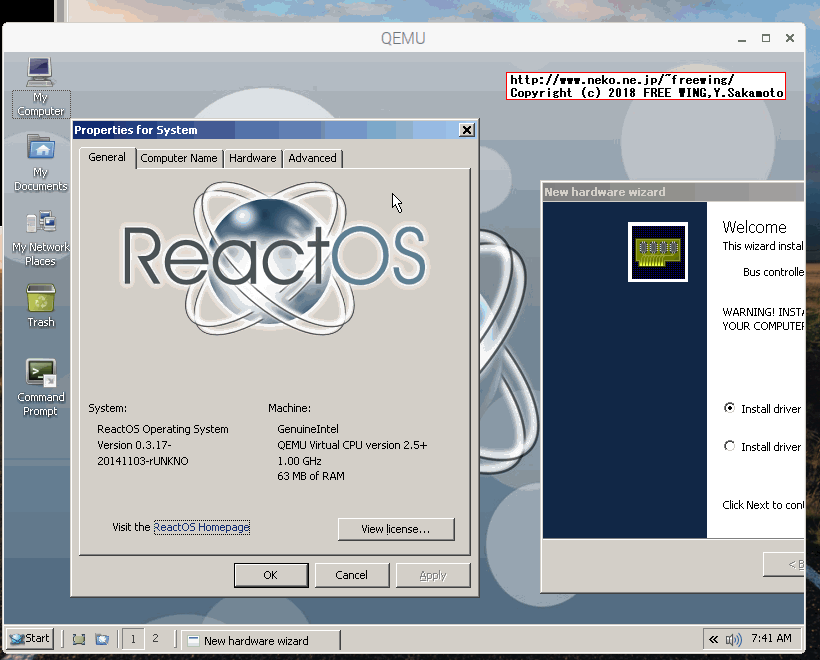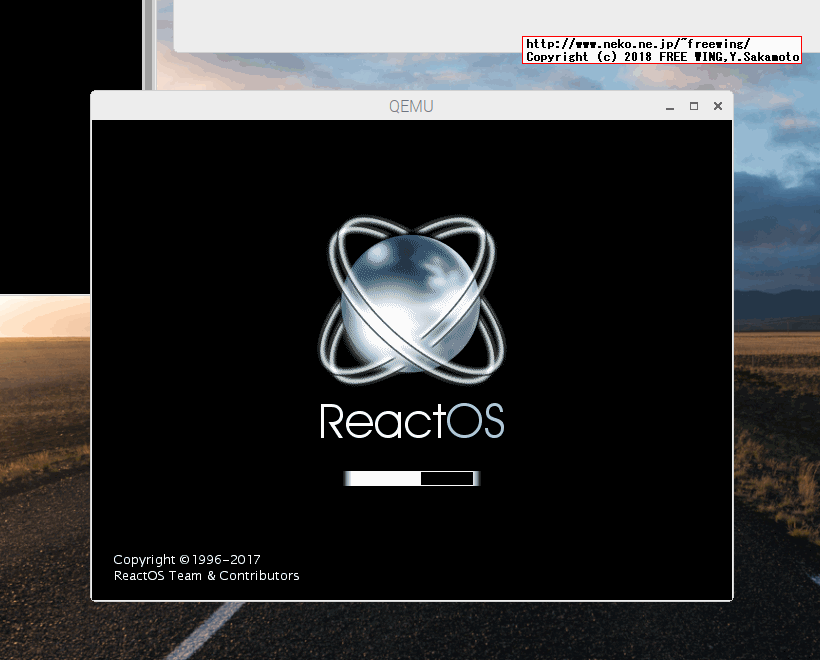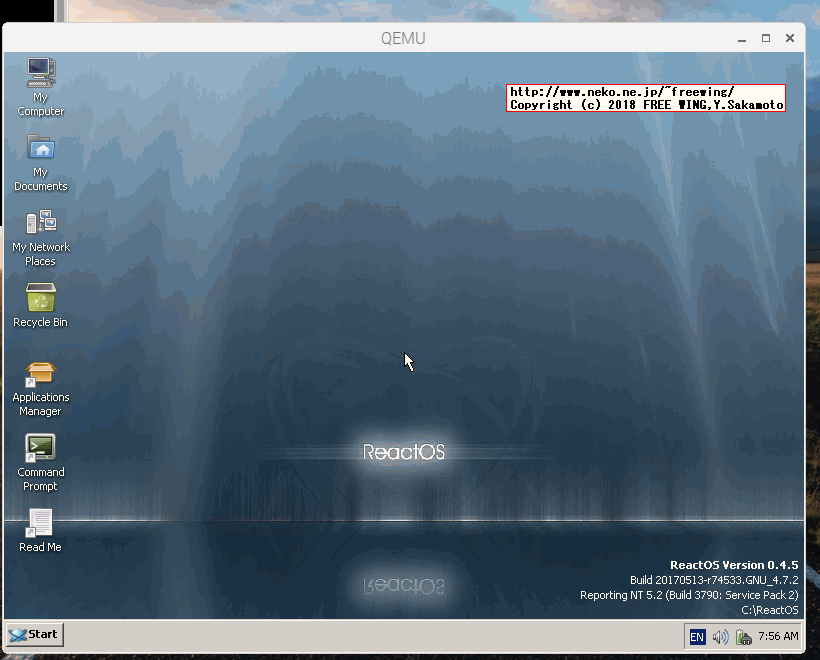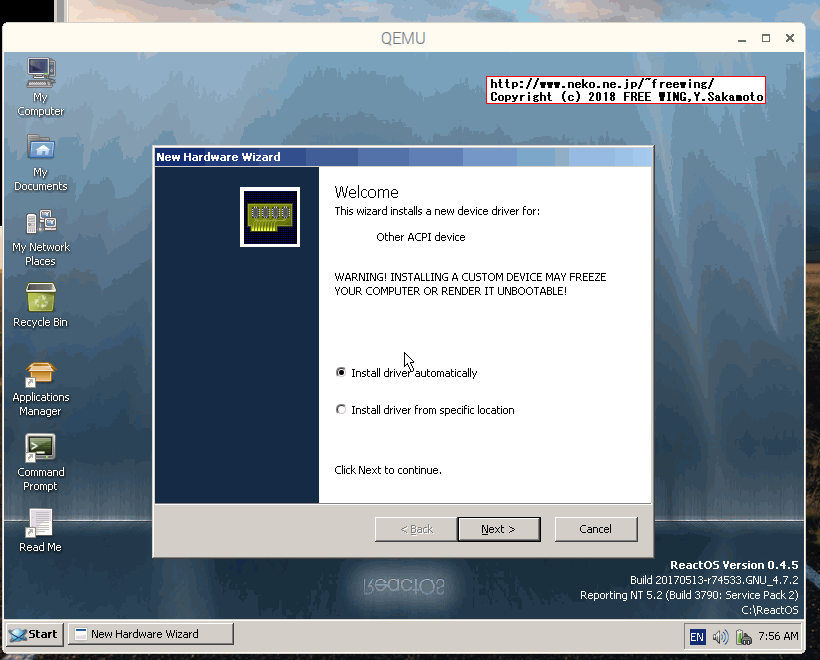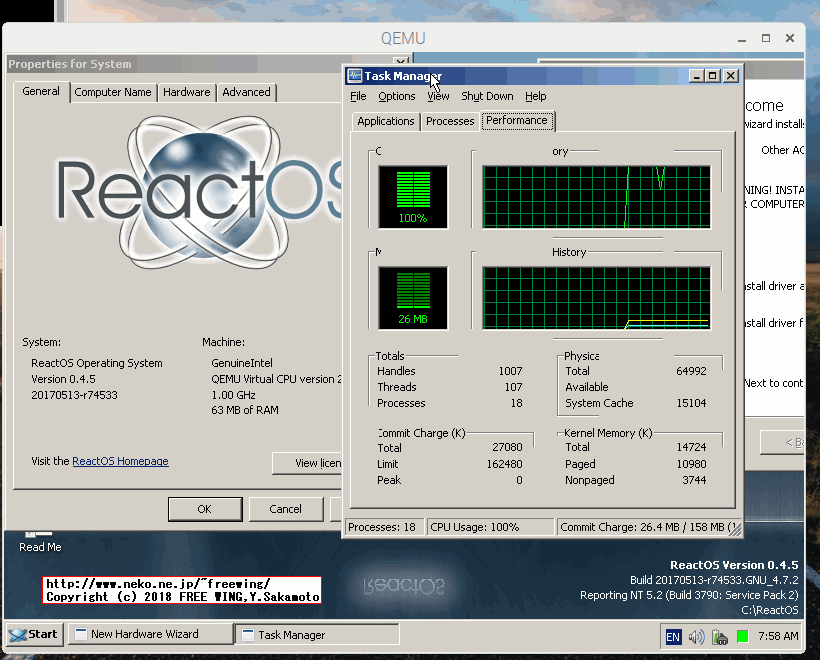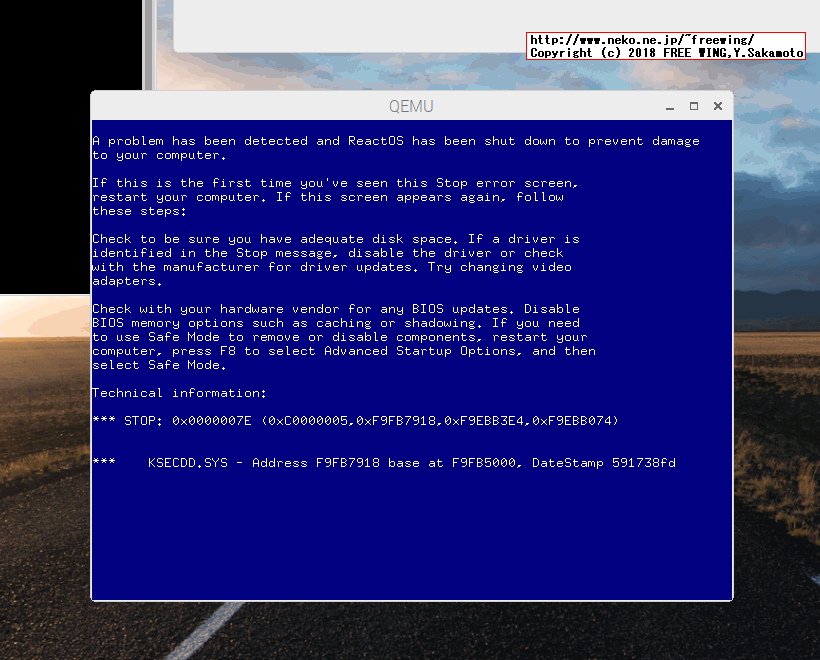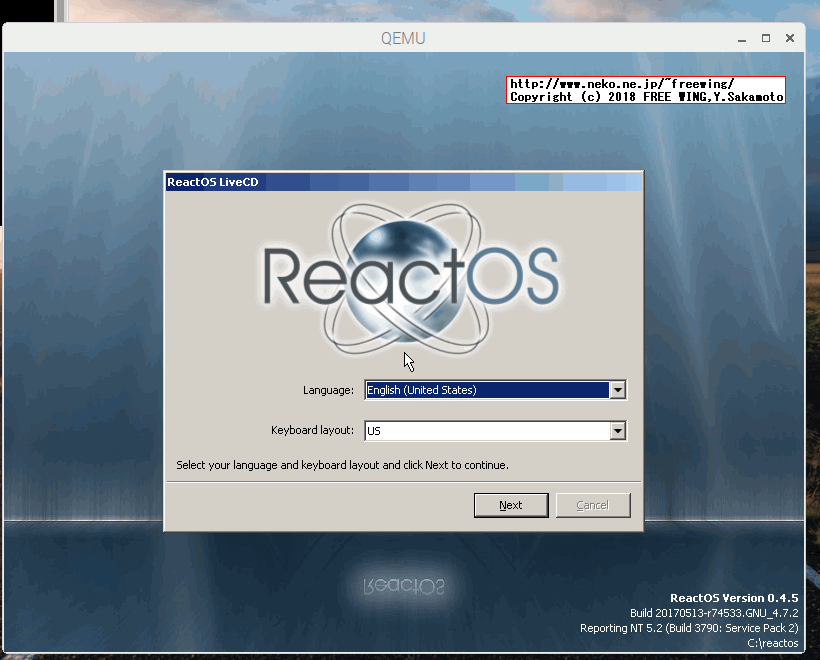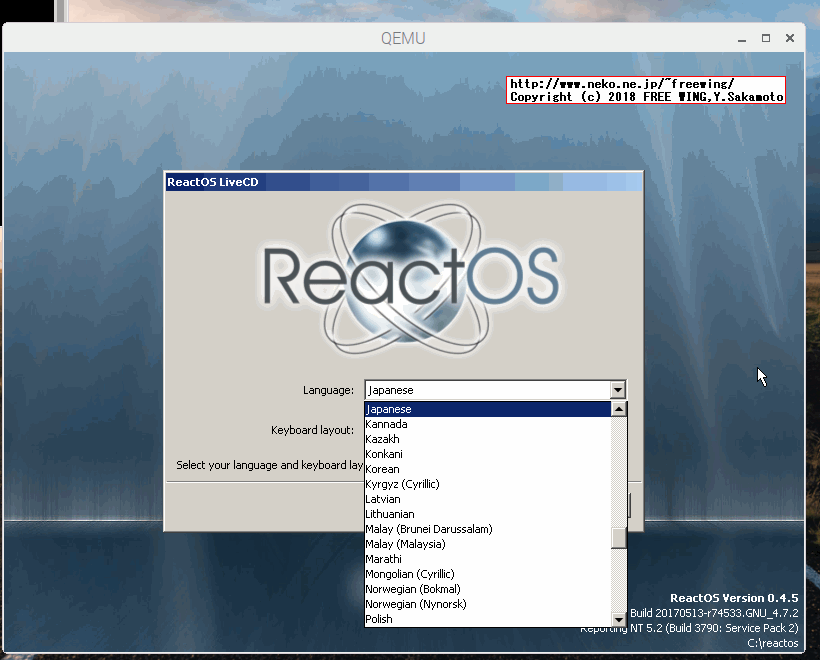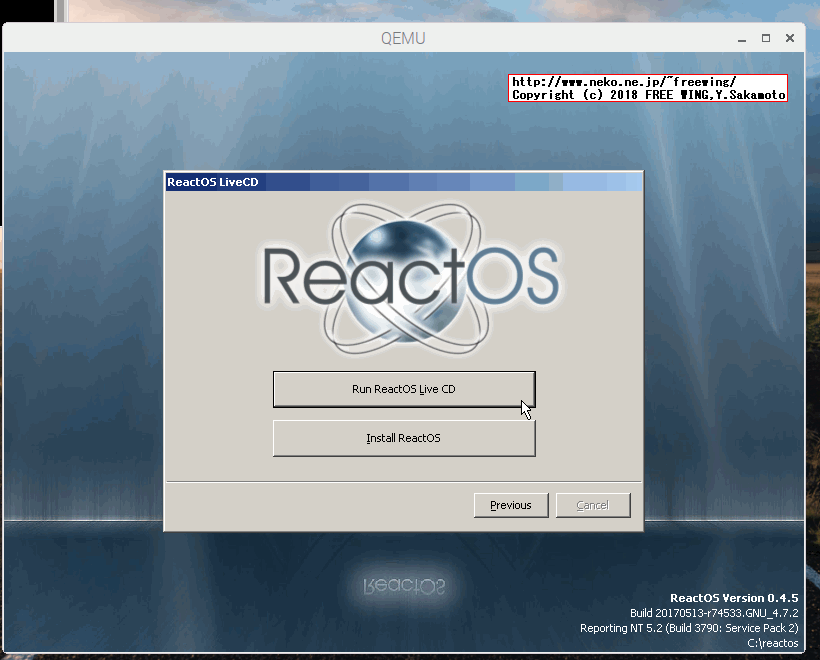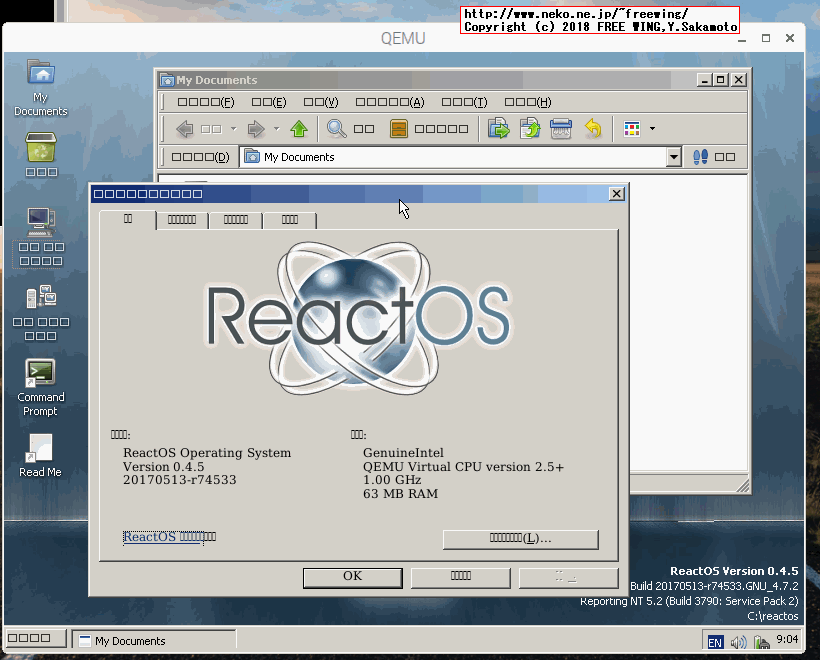・2018/04/30
 Raspberry Piの QEMUエミュレータで Windows互換の ReactOSを動かす方法
Raspberry Piの QEMUエミュレータで Windows互換の ReactOSを動かす方法
(ラズパイの QEMUエミュレータで ReactOSを動かしてみる(実用性は無し))
Tags: [Raspberry Pi], [電子工作]
● Raspberry Piの QEMUエミュレータで Windows互換 OSの ReactOSを動かす
ラズパイの QEMUエミュレータで ReactOSを動かせる事を知り、動かしてみました。
(動くだけで実用性は全く有りません。そこに ラズパイと QEMUと ReactOSが有るからみたいな。)
ReactOSとは Windows NT互換を目標にしているオープンソースのフリー OSです。(現在アルファ版で ReactOS自身の実用度も殆ど有りません)
ReactOS is a Free operating system.
ReactOS is a Opensource operating system.
Windows 2000をいじくっている時は ReactOSに大きな関心と期待を寄せていましたが、2018年現在では時既に遅しで価値を見出せなくなりました。(開発陣が未だにモチベーションを保って開発を継続している事には驚きを禁じ得ません)
Raspbian OSは Raspbian Stretch(2018/04/18版)を使用しました。
pi@raspberrypi:~ $ uname -a
Linux raspberrypi 4.14.34-v7+ #1110 SMP Mon Apr 16 15:18:51 BST 2018 armv7l GNU/Linux
ラズパイ本体は Pi 3B+を使用しました。
・2018/03/15

Raspberry Pi 3 Model B+を海外通販の Pimoroniでサクッと購入。ベンチマークレビュー
【国内技適待ち】ラズパイ3B+を海外通販で簡単に個人輸入で入手。従来の Pi3と速度比較
●ラズパイで QEMUエミュレータをビルドする
最初はお決まりの手順(apt-get update)で、次に QEMUのビルドに必要なライブラリをインストールします。
sudo apt-get update
sudo apt-get -y install git
sudo apt-get -y install zlib1g-dev
sudo apt-get -y install libsdl2-dev
sudo apt-get -y install libpixman-1-dev
QEMUを Gitから cloneしてソースリストを取得します。
cd
# git clone https://github.com/qemu/qemu.git
git clone git://git.qemu.org/qemu.git --branch v2.12.0 --single-branch --depth 1
# Note: checking out '4743c23509a51bd4ee85cc272287a41917d1be35'.
cd qemu
mkdir build
cd build
../configure --target-list="i386-softmmu" --enable-sdl
make
sudo make install
● ラズパイ用 QEMUエミュレータで ReactOSを動かす方法(VMware)
ReactOS An operating system based on the best Windows NT design principles
VMware形式のイメージで ReactOSの起動を確認。(ただし実用性は有りません)
※ ReactOSの VMware形式の提供は 0.4.5 2017-05-17が最後。
# ReactOS 0.3.17 VMware 2015-04-07 OK
wget https://excellmedia.dl.sourceforge.net/project/reactos/ReactOS/0.3.17/ReactOS-0.3.17-REL-VMware.zip
unzip ReactOS-0.3.17-REL-VMware.zip
qemu-system-i386 ReactOS.vmdk -m 64
# ReactOS 0.4.5 VMware 2017-05-17 OK
wget https://excellmedia.dl.sourceforge.net/project/reactos/ReactOS/0.4.5/ReactOS-0.4.5-REL-VMware.zip
unzip ReactOS-0.4.5-REL-VMware.zip
qemu-system-i386 ReactOS.vmdk -m 64
※-mのメモリの指定で 96を指定すると再起動ループで起動しない。
※-mのメモリの指定で 128とかを指定すると青画面で起動しない。
● ラズパイ用 QEMUエミュレータで ReactOSを動かす方法(Live CD)
# ReactOS 0.4.5 Live CD OK
wget https://jaist.dl.sourceforge.net/project/reactos/ReactOS/0.4.5/ReactOS-0.4.5-live.zip
unzip ReactOS-0.4.5-live.zip
qemu-system-i386 -cdrom ReactOS-0.4.5-Live.iso -m 64
# ReactOS 0.4.5は Live CDでも動きました
ReactOS 0.4.8の Live CD(Live.iso)は最初のローディング画面の後、黒画面になって起動しない。
# ReactOS-0.4.8-live.zip 76MB
# https://jaist.dl.sourceforge.net/project/reactos/ReactOS/0.4.8/ReactOS-0.4.8-live.zip
cd
wget https://jaist.dl.sourceforge.net/project/reactos/ReactOS/0.4.8/ReactOS-0.4.8-live.zip
unzip ReactOS-0.4.8-live.zip
# ReactOS-0.4.8-Live.iso 240MB
qemu-system-i386 -cdrom ReactOS-0.4.8-Live.iso -m 64
ReactOS 0.4.8は動きません
●ラズパイの QEMUエミュレータで Windows互換 OSの ReactOSを動かす
● ReactOS 0.3.17 VMware 2015-04-07 OK
・ReactOS 0.3.17 VMware 2015-04-07 on Raspberry Pi QEMU

・ReactOS 0.3.17 VMware 2015-04-07 on Raspberry Pi QEMU

・ReactOS 0.3.17 VMware 2015-04-07 on Raspberry Pi QEMU

・ReactOS 0.3.17 VMware 2015-04-07 on Raspberry Pi QEMU

・ReactOS 0.3.17 VMware 2015-04-07 on Raspberry Pi QEMU

・ReactOS 0.3.17 VMware 2015-04-07 on Raspberry Pi QEMU

● ReactOS 0.4.5 VMware 2017-05-17 OK
・ReactOS 0.4.5 VMware 2017-05-17 on Raspberry Pi QEMU

・ReactOS 0.4.5 VMware 2017-05-17 on Raspberry Pi QEMU

・ReactOS 0.4.5 VMware 2017-05-17 on Raspberry Pi QEMU

・ReactOS 0.4.5 VMware 2017-05-17 on Raspberry Pi QEMU

・ReactOS 0.4.5 VMware 2017-05-17 on Raspberry Pi QEMU

メモリ指定を 128にすると起動途中に BSoDのブルースクリーンでハングします。
● ReactOS 0.4.5 Live CD OK
・ReactOS 0.4.5 Live CD on Raspberry Pi QEMU

・ReactOS 0.4.5 Live CD on Raspberry Pi QEMU

・ReactOS 0.4.5 Live CD on Raspberry Pi QEMU

・ReactOS 0.4.5 Live CD on Raspberry Pi QEMU

Japaneseで日本語を選べますが、日本語の文字が全部トーフ文字(□文字)になります。
● ラズパイ用 QEMUのビルドでの注意点
● libsdl1.2-devだと、configure時に警告が出ます。
pi@raspberrypi:~ $ sudo apt-get -y install libsdl1.2-dev
pi@raspberrypi:~/qemu/build $ ../configure --target-list="i386-softmmu" --enable-sdl
WARNING: Use of SDL 1.2 is deprecated and will be removed in
WARNING: future releases. Please switch to using SDL 2.0
● libpixman-1-devが無いと、configure時にエラーが出ます。
pi@raspberrypi:~/qemu/build $ ../configure --target-list="i386-softmmu" --enable-sdl
ERROR: pixman >= 0.21.8 not present.
Please install the pixman devel package.
apt-cache search pixman
pi@raspberrypi:~/qemu/build $ apt-cache search pixman
libpixman-1-0 - pixel-manipulation library for X and cairo
libpixman-1-0-dbg - pixel-manipulation library for X and cairo (debugging symbols)
libpixman-1-dev - pixel-manipulation library for X and cairo (development files)
$ sudo apt-get -y install libpixman-1-dev
● QEMUの configure
pi@raspberrypi:~/qemu/build $ ../configure --help
Usage: configure [options]
Options: [defaults in brackets after descriptions]
Standard options:
--help print this message
--prefix=PREFIX install in PREFIX [/usr/local]
--interp-prefix=PREFIX where to find shared libraries, etc.
use %M for cpu name [/usr/gnemul/qemu-%M]
--target-list=LIST set target list (default: build everything)
Available targets: aarch64-softmmu alpha-softmmu
arm-softmmu cris-softmmu hppa-softmmu i386-softmmu
lm32-softmmu m68k-softmmu microblaze-softmmu
microblazeel-softmmu mips-softmmu mips64-softmmu
mips64el-softmmu mipsel-softmmu moxie-softmmu
nios2-softmmu or1k-softmmu ppc-softmmu ppc64-softmmu
ppcemb-softmmu riscv32-softmmu riscv64-softmmu
s390x-softmmu sh4-softmmu sh4eb-softmmu
sparc-softmmu sparc64-softmmu tricore-softmmu
unicore32-softmmu x86_64-softmmu xtensa-softmmu
xtensaeb-softmmu aarch64-linux-user
aarch64_be-linux-user alpha-linux-user
arm-linux-user armeb-linux-user cris-linux-user
hppa-linux-user i386-linux-user m68k-linux-user
microblaze-linux-user microblazeel-linux-user
mips-linux-user mips64-linux-user
mips64el-linux-user mipsel-linux-user
mipsn32-linux-user mipsn32el-linux-user
nios2-linux-user or1k-linux-user ppc-linux-user
ppc64-linux-user ppc64abi32-linux-user
ppc64le-linux-user riscv32-linux-user
riscv64-linux-user s390x-linux-user sh4-linux-user
sh4eb-linux-user sparc-linux-user
sparc32plus-linux-user sparc64-linux-user
tilegx-linux-user x86_64-linux-user
xtensa-linux-user xtensaeb-linux-user
Advanced options (experts only):
--source-path=PATH path of source code [/home/pi/qemu]
--cross-prefix=PREFIX use PREFIX for compile tools []
--cc=CC use C compiler CC [cc]
--iasl=IASL use ACPI compiler IASL [iasl]
--host-cc=CC use C compiler CC [cc] for code run at
build time
--cxx=CXX use C++ compiler CXX [c++]
--objcc=OBJCC use Objective-C compiler OBJCC [cc]
--extra-cflags=CFLAGS append extra C compiler flags QEMU_CFLAGS
--extra-cxxflags=CXXFLAGS append extra C++ compiler flags QEMU_CXXFLAGS
--extra-ldflags=LDFLAGS append extra linker flags LDFLAGS
--make=MAKE use specified make [make]
--install=INSTALL use specified install [install]
--python=PYTHON use specified python [python]
--smbd=SMBD use specified smbd [/usr/sbin/smbd]
--with-git=GIT use specified git [git]
--static enable static build [no]
--mandir=PATH install man pages in PATH
--datadir=PATH install firmware in PATH/qemu
--docdir=PATH install documentation in PATH/qemu
--bindir=PATH install binaries in PATH
--libdir=PATH install libraries in PATH
--libexecdir=PATH install helper binaries in PATH
--sysconfdir=PATH install config in PATH/qemu
--localstatedir=PATH install local state in PATH (set at runtime on win32)
--firmwarepath=PATH search PATH for firmware files
--with-confsuffix=SUFFIX suffix for QEMU data inside datadir/libdir/sysconfdir [/qemu]
--with-pkgversion=VERS use specified string as sub-version of the package
--enable-debug enable common debug build options
--enable-sanitizers enable default sanitizers
--disable-strip disable stripping binaries
--disable-werror disable compilation abort on warning
--disable-stack-protector disable compiler-provided stack protection
--audio-drv-list=LIST set audio drivers list:
Available drivers: oss alsa sdl pa
--block-drv-whitelist=L Same as --block-drv-rw-whitelist=L
--block-drv-rw-whitelist=L
set block driver read-write whitelist
(affects only QEMU, not qemu-img)
--block-drv-ro-whitelist=L
set block driver read-only whitelist
(affects only QEMU, not qemu-img)
--enable-trace-backends=B Set trace backend
Available backends: dtrace ftrace log simple syslog ust
--with-trace-file=NAME Full PATH,NAME of file to store traces
Default:trace-<pid>
--disable-slirp disable SLIRP userspace network connectivity
--enable-tcg-interpreter enable TCG with bytecode interpreter (TCI)
--enable-malloc-trim enable libc malloc_trim() for memory optimization
--oss-lib path to OSS library
--cpu=CPU Build for host CPU [arm]
--with-coroutine=BACKEND coroutine backend. Supported options:
ucontext, sigaltstack, windows
--enable-gcov enable test coverage analysis with gcov
--gcov=GCOV use specified gcov [gcov]
--disable-blobs disable installing provided firmware blobs
--with-vss-sdk=SDK-path enable Windows VSS support in QEMU Guest Agent
--with-win-sdk=SDK-path path to Windows Platform SDK (to build VSS .tlb)
--tls-priority default TLS protocol/cipher priority string
--enable-gprof QEMU profiling with gprof
--enable-profiler profiler support
--enable-xen-pv-domain-build
xen pv domain builder
--enable-debug-stack-usage
track the maximum stack usage of stacks created by qemu_alloc_stack
Optional features, enabled with --enable-FEATURE and
disabled with --disable-FEATURE, default is enabled if available:
system all system emulation targets
user supported user emulation targets
linux-user all linux usermode emulation targets
bsd-user all BSD usermode emulation targets
docs build documentation
guest-agent build the QEMU Guest Agent
guest-agent-msi build guest agent Windows MSI installation package
pie Position Independent Executables
modules modules support
debug-tcg TCG debugging (default is disabled)
debug-info debugging information
sparse sparse checker
gnutls GNUTLS cryptography support
nettle nettle cryptography support
gcrypt libgcrypt cryptography support
sdl SDL UI
--with-sdlabi select preferred SDL ABI 1.2 or 2.0
gtk gtk UI
--with-gtkabi select preferred GTK ABI 2.0 or 3.0
vte vte support for the gtk UI
curses curses UI
vnc VNC UI support
vnc-sasl SASL encryption for VNC server
vnc-jpeg JPEG lossy compression for VNC server
vnc-png PNG compression for VNC server
cocoa Cocoa UI (Mac OS X only)
virtfs VirtFS
mpath Multipath persistent reservation passthrough
xen xen backend driver support
xen-pci-passthrough
brlapi BrlAPI (Braile)
curl curl connectivity
membarrier membarrier system call (for Linux 4.14+ or Windows)
fdt fdt device tree
bluez bluez stack connectivity
kvm KVM acceleration support
hax HAX acceleration support
hvf Hypervisor.framework acceleration support
whpx Windows Hypervisor Platform acceleration support
rdma Enable RDMA-based migration and PVRDMA support
vde support for vde network
netmap support for netmap network
linux-aio Linux AIO support
cap-ng libcap-ng support
attr attr and xattr support
vhost-net vhost-net acceleration support
vhost-crypto vhost-crypto acceleration support
spice spice
rbd rados block device (rbd)
libiscsi iscsi support
libnfs nfs support
smartcard smartcard support (libcacard)
libusb libusb (for usb passthrough)
live-block-migration Block migration in the main migration stream
usb-redir usb network redirection support
lzo support of lzo compression library
snappy support of snappy compression library
bzip2 support of bzip2 compression library
(for reading bzip2-compressed dmg images)
seccomp seccomp support
coroutine-pool coroutine freelist (better performance)
glusterfs GlusterFS backend
tpm TPM support
libssh2 ssh block device support
numa libnuma support
libxml2 for Parallels image format
tcmalloc tcmalloc support
jemalloc jemalloc support
replication replication support
vhost-vsock virtio sockets device support
opengl opengl support
virglrenderer virgl rendering support
xfsctl xfsctl support
qom-cast-debug cast debugging support
tools build qemu-io, qemu-nbd and qemu-image tools
vxhs Veritas HyperScale vDisk backend support
crypto-afalg Linux AF_ALG crypto backend driver
vhost-user vhost-user support
capstone capstone disassembler support
NOTE: The object files are built at the place where configure is launched
● QEMUのバージョン
qemu-system-i386 -version
pi@raspberrypi:~/qemu/build $ qemu-system-i386 -version
QEMU emulator version 2.12.50 (v2.12.0-258-gc8b7e627b4-dirty)
Copyright (c) 2003-2017 Fabrice Bellard and the QEMU Project developers
pi@raspberrypi:~ $ ls -l /usr/local/bin
total 13416
-rwxr-xr-x 1 root staff 13960 May 5 06:28 ivshmem-client
-rwxr-xr-x 1 root staff 153636 May 5 06:28 ivshmem-server
-rwxr-xr-x 1 root staff 285296 May 5 06:28 qemu-ga
-rwxr-xr-x 1 root staff 1197048 May 5 06:28 qemu-img
-rwxr-xr-x 1 root staff 1156076 May 5 06:28 qemu-io
-rwxr-xr-x 1 root staff 406136 May 5 06:28 qemu-keymap
-rwxr-xr-x 1 root staff 1160144 May 5 06:28 qemu-nbd
-rwxr-xr-x 1 root staff 393376 May 5 06:28 qemu-pr-helper
-rwxr-xr-x 1 root staff 8948492 May 5 06:28 qemu-system-i386
SSHコンソール上で実行しても X11(グラフィック画面)が無いと言って怒られます。
pi@raspberrypi:~/qemu/build $ qemu-system-i386
Could not initialize SDL(x11 not available) - exiting
qemu-system-i386 -h
pi@raspberrypi:~/qemu/build $ qemu-system-i386 -h
QEMU emulator version 2.12.50 (v2.12.0-258-gc8b7e627b4-dirty)
Copyright (c) 2003-2017 Fabrice Bellard and the QEMU Project developers
usage: qemu-system-i386 [options] [disk_image]
'disk_image' is a raw hard disk image for IDE hard disk 0
Standard options:
-h or -help display this help and exit
-version display version information and exit
-machine [type=]name[,prop[=value][,...]]
selects emulated machine ('-machine help' for list)
property accel=accel1[:accel2[:...]] selects accelerator
supported accelerators are kvm, xen, hax, hvf, whpx or tcg (default: tcg)
kernel_irqchip=on|off|split controls accelerated irqchip support (default=off)
vmport=on|off|auto controls emulation of vmport (default: auto)
kvm_shadow_mem=size of KVM shadow MMU in bytes
dump-guest-core=on|off include guest memory in a core dump (default=on)
mem-merge=on|off controls memory merge support (default: on)
igd-passthru=on|off controls IGD GFX passthrough support (default=off)
aes-key-wrap=on|off controls support for AES key wrapping (default=on)
dea-key-wrap=on|off controls support for DEA key wrapping (default=on)
suppress-vmdesc=on|off disables self-describing migration (default=off)
nvdimm=on|off controls NVDIMM support (default=off)
enforce-config-section=on|off enforce configuration section migration (default=off)
s390-squash-mcss=on|off (deprecated) controls support for squashing into default css (default=off)
memory-encryption=@var{} memory encryption object to use (default=none)
-cpu cpu select CPU ('-cpu help' for list)
-accel [accel=]accelerator[,thread=single|multi]
select accelerator (kvm, xen, hax, hvf, whpx or tcg; use 'help' for a list)
thread=single|multi (enable multi-threaded TCG)-smp [cpus=]n[,maxcpus=cpus][,cores=cores][,threads=threads][,sockets=sockets]
set the number of CPUs to 'n' [default=1]
maxcpus= maximum number of total cpus, including
offline CPUs for hotplug, etc
cores= number of CPU cores on one socket
threads= number of threads on one CPU core
sockets= number of discrete sockets in the system
-numa node[,mem=size][,cpus=firstcpu[-lastcpu]][,nodeid=node]
-numa node[,memdev=id][,cpus=firstcpu[-lastcpu]][,nodeid=node]
-numa dist,src=source,dst=destination,val=distance
-numa cpu,node-id=node[,socket-id=x][,core-id=y][,thread-id=z]
-add-fd fd=fd,set=set[,opaque=opaque]
Add 'fd' to fd 'set'
-set group.id.arg=value
set <arg> parameter for item <id> of type <group>
i.e. -set drive.$id.file=/path/to/image
-global driver.property=value
-global driver=driver,property=property,value=value
set a global default for a driver property
-boot [order=drives][,once=drives][,menu=on|off]
[,splash=sp_name][,splash-time=sp_time][,reboot-timeout=rb_time][,strict=on|off]
'drives': floppy (a), hard disk (c), CD-ROM (d), network (n)
'sp_name': the file's name that would be passed to bios as logo picture, if menu=on
'sp_time': the period that splash picture last if menu=on, unit is ms
'rb_timeout': the timeout before guest reboot when boot failed, unit is ms
-m [size=]megs[,slots=n,maxmem=size]
configure guest RAM
size: initial amount of guest memory
slots: number of hotplug slots (default: none)
maxmem: maximum amount of guest memory (default: none)
NOTE: Some architectures might enforce a specific granularity
-mem-path FILE provide backing storage for guest RAM
-mem-prealloc preallocate guest memory (use with -mem-path)
-k language use keyboard layout (for example 'fr' for French)
-audio-help print list of audio drivers and their options
-soundhw c1,... enable audio support
and only specified sound cards (comma separated list)
use '-soundhw help' to get the list of supported cards
use '-soundhw all' to enable all of them
-balloon virtio[,addr=str]
enable virtio balloon device (deprecated)
-device driver[,prop[=value][,...]]
add device (based on driver)
prop=value,... sets driver properties
use '-device help' to print all possible drivers
use '-device driver,help' to print all possible properties
-name string1[,process=string2][,debug-threads=on|off]
set the name of the guest
string1 sets the window title and string2 the process name (on Linux)
When debug-threads is enabled, individual threads are given a separate name (on Linux)
NOTE: The thread names are for debugging and not a stable API.
-uuid %08x-%04x-%04x-%04x-%012x
specify machine UUID
Block device options:
-fda/-fdb file use 'file' as floppy disk 0/1 image
-hda/-hdb file use 'file' as IDE hard disk 0/1 image
-hdc/-hdd file use 'file' as IDE hard disk 2/3 image
-cdrom file use 'file' as IDE cdrom image (cdrom is ide1 master)
-blockdev [driver=]driver[,node-name=N][,discard=ignore|unmap]
[,cache.direct=on|off][,cache.no-flush=on|off]
[,read-only=on|off][,detect-zeroes=on|off|unmap]
[,driver specific parameters...]
configure a block backend
-drive [file=file][,if=type][,bus=n][,unit=m][,media=d][,index=i]m
[,cyls=c,heads=h,secs=s[,trans=t]][,snapshot=on|off]
[,cache=writethrough|writeback|none|directsync|unsafe][,format=f]
[,serial=s][,addr=A][,rerror=ignore|stop|report]
[,werror=ignore|stop|report|enospc][,id=name][,aio=threads|native]
[,readonly=on|off][,copy-on-read=on|off]
[,discard=ignore|unmap][,detect-zeroes=on|off|unmap]
[[,bps=b]|[[,bps_rd=r][,bps_wr=w]]]
[[,iops=i]|[[,iops_rd=r][,iops_wr=w]]]
[[,bps_max=bm]|[[,bps_rd_max=rm][,bps_wr_max=wm]]]
[[,iops_max=im]|[[,iops_rd_max=irm][,iops_wr_max=iwm]]]
[[,iops_size=is]]
[[,group=g]]
use 'file' as a drive image
-mtdblock file use 'file' as on-board Flash memory image
-sd file use 'file' as SecureDigital card image
-pflash file use 'file' as a parallel flash image
-snapshot write to temporary files instead of disk image files
-fsdev fsdriver,id=id[,path=path,][security_model={mapped-xattr|mapped-file|passthrough|none}]
[,writeout=immediate][,readonly][,socket=socket|sock_fd=sock_fd][,fmode=fmode][,dmode=dmode]
[[,throttling.bps-total=b]|[[,throttling.bps-read=r][,throttling.bps-write=w]]]
[[,throttling.iops-total=i]|[[,throttling.iops-read=r][,throttling.iops-write=w]]]
[[,throttling.bps-total-max=bm]|[[,throttling.bps-read-max=rm][,throttling.bps-write-max=wm]]]
[[,throttling.iops-total-max=im]|[[,throttling.iops-read-max=irm][,throttling.iops-write-max=iwm]]]
[[,throttling.iops-size=is]]
-virtfs local,path=path,mount_tag=tag,security_model=[mapped-xattr|mapped-file|passthrough|none]
[,id=id][,writeout=immediate][,readonly][,socket=socket|sock_fd=sock_fd][,fmode=fmode][,dmode=dmode]
-virtfs_synth Create synthetic file system image
-iscsi [user=user][,password=password]
[,header-digest=CRC32C|CR32C-NONE|NONE-CRC32C|NONE
[,initiator-name=initiator-iqn][,id=target-iqn]
[,timeout=timeout]
iSCSI session parameters
USB options:
-usb enable the USB driver (if it is not used by default yet)
-usbdevice name add the host or guest USB device 'name'
Display options:
-display sdl[,frame=on|off][,alt_grab=on|off][,ctrl_grab=on|off]
[,window_close=on|off][,gl=on|core|es|off]
-display gtk[,grab_on_hover=on|off][,gl=on|off]|
-display vnc=<display>[,<optargs>]
-display curses
-display none select display type
The default display is equivalent to
"-display sdl"
-nographic disable graphical output and redirect serial I/Os to console
-curses shorthand for -display curses
-no-frame open SDL window without a frame and window decorations
-alt-grab use Ctrl-Alt-Shift to grab mouse (instead of Ctrl-Alt)
-ctrl-grab use Right-Ctrl to grab mouse (instead of Ctrl-Alt)
-no-quit disable SDL window close capability
-sdl shorthand for -display sdl
-spice [port=port][,tls-port=secured-port][,x509-dir=<dir>]
[,x509-key-file=<file>][,x509-key-password=<file>]
[,x509-cert-file=<file>][,x509-cacert-file=<file>]
[,x509-dh-key-file=<file>][,addr=addr][,ipv4|ipv6|unix]
[,tls-ciphers=<list>]
[,tls-channel=[main|display|cursor|inputs|record|playback]]
[,plaintext-channel=[main|display|cursor|inputs|record|playback]]
[,sasl][,password=<secret>][,disable-ticketing]
[,image-compression=[auto_glz|auto_lz|quic|glz|lz|off]]
[,jpeg-wan-compression=[auto|never|always]]
[,zlib-glz-wan-compression=[auto|never|always]]
[,streaming-video=[off|all|filter]][,disable-copy-paste]
[,disable-agent-file-xfer][,agent-mouse=[on|off]]
[,playback-compression=[on|off]][,seamless-migration=[on|off]]
[,gl=[on|off]][,rendernode=<file>]
enable spice
at least one of {port, tls-port} is mandatory
-portrait rotate graphical output 90 deg left (only PXA LCD)
-rotate <deg> rotate graphical output some deg left (only PXA LCD)
-vga [std|cirrus|vmware|qxl|xenfb|tcx|cg3|virtio|none]
select video card type
-full-screen start in full screen
-vnc <display> shorthand for -display vnc=<display>
i386 target only:
-win2k-hack use it when installing Windows 2000 to avoid a disk full bug
-no-fd-bootchk disable boot signature checking for floppy disks
-no-acpi disable ACPI
-no-hpet disable HPET
-acpitable [sig=str][,rev=n][,oem_id=str][,oem_table_id=str][,oem_rev=n][,asl_compiler_id=str][,asl_compiler_rev=n][,{data|file}=file1[:file2]...]
ACPI table description
-smbios file=binary
load SMBIOS entry from binary file
-smbios type=0[,vendor=str][,version=str][,date=str][,release=%d.%d]
[,uefi=on|off]
specify SMBIOS type 0 fields
-smbios type=1[,manufacturer=str][,product=str][,version=str][,serial=str]
[,uuid=uuid][,sku=str][,family=str]
specify SMBIOS type 1 fields
-smbios type=2[,manufacturer=str][,product=str][,version=str][,serial=str]
[,asset=str][,location=str]
specify SMBIOS type 2 fields
-smbios type=3[,manufacturer=str][,version=str][,serial=str][,asset=str]
[,sku=str]
specify SMBIOS type 3 fields
-smbios type=4[,sock_pfx=str][,manufacturer=str][,version=str][,serial=str]
[,asset=str][,part=str]
specify SMBIOS type 4 fields
-smbios type=17[,loc_pfx=str][,bank=str][,manufacturer=str][,serial=str]
[,asset=str][,part=str][,speed=%d]
specify SMBIOS type 17 fields
Network options:
-netdev user,id=str[,ipv4[=on|off]][,net=addr[/mask]][,host=addr]
[,ipv6[=on|off]][,ipv6-net=addr[/int]][,ipv6-host=addr]
[,restrict=on|off][,hostname=host][,dhcpstart=addr]
[,dns=addr][,ipv6-dns=addr][,dnssearch=domain][,tftp=dir]
[,bootfile=f][,hostfwd=rule][,guestfwd=rule][,smb=dir[,smbserver=addr]]
configure a user mode network backend with ID 'str',
its DHCP server and optional services
-netdev tap,id=str[,fd=h][,fds=x:y:...:z][,ifname=name][,script=file][,downscript=dfile]
[,br=bridge][,helper=helper][,sndbuf=nbytes][,vnet_hdr=on|off][,vhost=on|off]
[,vhostfd=h][,vhostfds=x:y:...:z][,vhostforce=on|off][,queues=n]
[,poll-us=n]
configure a host TAP network backend with ID 'str'
connected to a bridge (default=br0)
use network scripts 'file' (default=/etc/qemu-ifup)
to configure it and 'dfile' (default=/etc/qemu-ifdown)
to deconfigure it
use '[down]script=no' to disable script execution
use network helper 'helper' (default=/usr/local/libexec/qemu-bridge-helper) to
configure it
use 'fd=h' to connect to an already opened TAP interface
use 'fds=x:y:...:z' to connect to already opened multiqueue capable TAP interfaces
use 'sndbuf=nbytes' to limit the size of the send buffer (the
default is disabled 'sndbuf=0' to enable flow control set 'sndbuf=1048576')
use vnet_hdr=off to avoid enabling the IFF_VNET_HDR tap flag
use vnet_hdr=on to make the lack of IFF_VNET_HDR support an error condition
use vhost=on to enable experimental in kernel accelerator
(only has effect for virtio guests which use MSIX)
use vhostforce=on to force vhost on for non-MSIX virtio guests
use 'vhostfd=h' to connect to an already opened vhost net device
use 'vhostfds=x:y:...:z to connect to multiple already opened vhost net devices
use 'queues=n' to specify the number of queues to be created for multiqueue TAP
use 'poll-us=n' to speciy the maximum number of microseconds that could be
spent on busy polling for vhost net
-netdev bridge,id=str[,br=bridge][,helper=helper]
configure a host TAP network backend with ID 'str' that is
connected to a bridge (default=br0)
using the program 'helper (default=/usr/local/libexec/qemu-bridge-helper)
-netdev l2tpv3,id=str,src=srcaddr,dst=dstaddr[,srcport=srcport][,dstport=dstport]
[,rxsession=rxsession],txsession=txsession[,ipv6=on/off][,udp=on/off]
[,cookie64=on/off][,counter][,pincounter][,txcookie=txcookie]
[,rxcookie=rxcookie][,offset=offset]
configure a network backend with ID 'str' connected to
an Ethernet over L2TPv3 pseudowire.
Linux kernel 3.3+ as well as most routers can talk
L2TPv3. This transport allows connecting a VM to a VM,
VM to a router and even VM to Host. It is a nearly-universal
standard (RFC3391). Note - this implementation uses static
pre-configured tunnels (same as the Linux kernel).
use 'src=' to specify source address
use 'dst=' to specify destination address
use 'udp=on' to specify udp encapsulation
use 'srcport=' to specify source udp port
use 'dstport=' to specify destination udp port
use 'ipv6=on' to force v6
L2TPv3 uses cookies to prevent misconfiguration as
well as a weak security measure
use 'rxcookie=0x012345678' to specify a rxcookie
use 'txcookie=0x012345678' to specify a txcookie
use 'cookie64=on' to set cookie size to 64 bit, otherwise 32
use 'counter=off' to force a 'cut-down' L2TPv3 with no counter
use 'pincounter=on' to work around broken counter handling in peer
use 'offset=X' to add an extra offset between header and data
-netdev socket,id=str[,fd=h][,listen=[host]:port][,connect=host:port]
configure a network backend to connect to another network
using a socket connection
-netdev socket,id=str[,fd=h][,mcast=maddr:port[,localaddr=addr]]
configure a network backend to connect to a multicast maddr and port
use 'localaddr=addr' to specify the host address to send packets from
-netdev socket,id=str[,fd=h][,udp=host:port][,localaddr=host:port]
configure a network backend to connect to another network
using an UDP tunnel
-netdev vhost-user,id=str,chardev=dev[,vhostforce=on|off]
configure a vhost-user network, backed by a chardev 'dev'
-netdev hubport,id=str,hubid=n[,netdev=nd]
configure a hub port on QEMU VLAN 'n'
--nic [tap|bridge|user|l2tpv3|vhost-user|socket][,option][,...][mac=macaddr]
initialize an on-board / default host NIC (using MAC address
macaddr) and connect it to the given host network backend
--nic none use it alone to have zero network devices (the default is to
provided a 'user' network connection)
-net nic[,vlan=n][,netdev=nd][,macaddr=mac][,model=type][,name=str][,addr=str][,vectors=v]
configure or create an on-board (or machine default) NIC and
connect it either to VLAN 'n' or the netdev 'nd' (for pluggable
NICs please use '-device devtype,netdev=nd' instead)
-net [user|tap|bridge|socket][,vlan=n][,option][,option][,...]
old way to initialize a host network interface
(use the -netdev option if possible instead)
Character device options:
-chardev help
-chardev null,id=id[,mux=on|off][,logfile=PATH][,logappend=on|off]
-chardev socket,id=id[,host=host],port=port[,to=to][,ipv4][,ipv6][,nodelay][,reconnect=seconds]
[,server][,nowait][,telnet][,reconnect=seconds][,mux=on|off]
[,logfile=PATH][,logappend=on|off][,tls-creds=ID] (tcp)
-chardev socket,id=id,path=path[,server][,nowait][,telnet][,reconnect=seconds]
[,mux=on|off][,logfile=PATH][,logappend=on|off] (unix)
-chardev udp,id=id[,host=host],port=port[,localaddr=localaddr]
[,localport=localport][,ipv4][,ipv6][,mux=on|off]
[,logfile=PATH][,logappend=on|off]
-chardev msmouse,id=id[,mux=on|off][,logfile=PATH][,logappend=on|off]
-chardev vc,id=id[[,width=width][,height=height]][[,cols=cols][,rows=rows]]
[,mux=on|off][,logfile=PATH][,logappend=on|off]
-chardev ringbuf,id=id[,size=size][,logfile=PATH][,logappend=on|off]
-chardev file,id=id,path=path[,mux=on|off][,logfile=PATH][,logappend=on|off]
-chardev pipe,id=id,path=path[,mux=on|off][,logfile=PATH][,logappend=on|off]
-chardev pty,id=id[,mux=on|off][,logfile=PATH][,logappend=on|off]
-chardev stdio,id=id[,mux=on|off][,signal=on|off][,logfile=PATH][,logappend=on|off]
-chardev serial,id=id,path=path[,mux=on|off][,logfile=PATH][,logappend=on|off]
-chardev tty,id=id,path=path[,mux=on|off][,logfile=PATH][,logappend=on|off]
-chardev parallel,id=id,path=path[,mux=on|off][,logfile=PATH][,logappend=on|off]
-chardev parport,id=id,path=path[,mux=on|off][,logfile=PATH][,logappend=on|off]
Bluetooth(R) options:
-bt hci,null dumb bluetooth HCI - doesn't respond to commands
-bt hci,host[:id]
use host's HCI with the given name
-bt hci[,vlan=n]
emulate a standard HCI in virtual scatternet 'n'
-bt vhci[,vlan=n]
add host computer to virtual scatternet 'n' using VHCI
-bt device:dev[,vlan=n]
emulate a bluetooth device 'dev' in scatternet 'n'
TPM device options:
-tpmdev passthrough,id=id[,path=path][,cancel-path=path]
use path to provide path to a character device; default is /dev/tpm0
use cancel-path to provide path to TPM's cancel sysfs entry; if
not provided it will be searched for in /sys/class/misc/tpm?/device
-tpmdev emulator,id=id,chardev=dev
configure the TPM device using chardev backend
Linux/Multiboot boot specific:
-kernel bzImage use 'bzImage' as kernel image
-append cmdline use 'cmdline' as kernel command line
-initrd file use 'file' as initial ram disk
-dtb file use 'file' as device tree image
Debug/Expert options:
-fw_cfg [name=]<name>,file=<file>
add named fw_cfg entry with contents from file
-fw_cfg [name=]<name>,string=<str>
add named fw_cfg entry with contents from string
-serial dev redirect the serial port to char device 'dev'
-parallel dev redirect the parallel port to char device 'dev'
-monitor dev redirect the monitor to char device 'dev'
-qmp dev like -monitor but opens in 'control' mode
-qmp-pretty dev like -qmp but uses pretty JSON formatting
-mon [chardev=]name[,mode=readline|control][,pretty[=on|off]]
-debugcon dev redirect the debug console to char device 'dev'
-pidfile file write PID to 'file'
-singlestep always run in singlestep mode
-S freeze CPU at startup (use 'c' to start execution)
-realtime [mlock=on|off]
run qemu with realtime features
mlock=on|off controls mlock support (default: on)
-gdb dev wait for gdb connection on 'dev'
-s shorthand for -gdb tcp::1234
-d item1,... enable logging of specified items (use '-d help' for a list of log items)
-D logfile output log to logfile (default stderr)
-dfilter range,.. filter debug output to range of addresses (useful for -d cpu,exec,etc..)
-L path set the directory for the BIOS, VGA BIOS and keymaps
-bios file set the filename for the BIOS
-enable-kvm enable KVM full virtualization support
-enable-hax enable HAX virtualization support
-xen-domid id specify xen guest domain id
-xen-create create domain using xen hypercalls, bypassing xend
warning: should not be used when xend is in use
-xen-attach attach to existing xen domain
xend will use this when starting QEMU
-xen-domid-restrict restrict set of available xen operations
to specified domain id. (Does not affect
xenpv machine type).
-no-reboot exit instead of rebooting
-no-shutdown stop before shutdown
-loadvm [tag|id]
start right away with a saved state (loadvm in monitor)
-daemonize daemonize QEMU after initializing
-option-rom rom load a file, rom, into the option ROM space
-rtc [base=utc|localtime|date][,clock=host|rt|vm][,driftfix=none|slew]
set the RTC base and clock, enable drift fix for clock ticks (x86 only)
-icount [shift=N|auto][,align=on|off][,sleep=on|off,rr=record|replay,rrfile=<filename>,rrsnapshot=<snapshot>]
enable virtual instruction counter with 2^N clock ticks per
instruction, enable aligning the host and virtual clocks
or disable real time cpu sleeping
-watchdog model
enable virtual hardware watchdog [default=none]
-watchdog-action reset|shutdown|poweroff|inject-nmi|pause|debug|none
action when watchdog fires [default=reset]
-echr chr set terminal escape character instead of ctrl-a
-virtioconsole c
set virtio console
-show-cursor show cursor
-tb-size n set TB size
-incoming tcp:[host]:port[,to=maxport][,ipv4][,ipv6]
-incoming rdma:host:port[,ipv4][,ipv6]
-incoming unix:socketpath
prepare for incoming migration, listen on
specified protocol and socket address
-incoming fd:fd
-incoming exec:cmdline
accept incoming migration on given file descriptor
or from given external command
-incoming defer
wait for the URI to be specified via migrate_incoming
-only-migratable allow only migratable devices
-nodefaults don't create default devices
-chroot dir chroot to dir just before starting the VM
-runas user change to user id user just before starting the VM
user can be numeric uid:gid instead
-sandbox on[,obsolete=allow|deny][,elevateprivileges=allow|deny|children]
[,spawn=allow|deny][,resourcecontrol=allow|deny]
Enable seccomp mode 2 system call filter (default 'off').
use 'obsolete' to allow obsolete system calls that are provided
by the kernel, but typically no longer used by modern
C library implementations.
use 'elevateprivileges' to allow or deny QEMU process to elevate
its privileges by blacklisting all set*uid|gid system calls.
The value 'children' will deny set*uid|gid system calls for
main QEMU process but will allow forks and execves to run unprivileged
use 'spawn' to avoid QEMU to spawn new threads or processes by
blacklisting *fork and execve
use 'resourcecontrol' to disable process affinity and schedular priority
-readconfig <file>
-writeconfig <file>
read/write config file
-no-user-config
do not load default user-provided config files at startup
-trace [[enable=]<pattern>][,events=<file>][,file=<file>]
specify tracing options
-enable-fips enable FIPS 140-2 compliance
-msg timestamp[=on|off]
change the format of messages
on|off controls leading timestamps (default:on)
-dump-vmstate <file>
Output vmstate information in JSON format to file.
Use the scripts/vmstate-static-checker.py file to
check for possible regressions in migration code
by comparing two such vmstate dumps.
Generic object creation:
-object TYPENAME[,PROP1=VALUE1,...]
create a new object of type TYPENAME setting properties
in the order they are specified. Note that the 'id'
property must be set. These objects are placed in the
'/objects' path.
During emulation, the following keys are useful:
ctrl-alt-f toggle full screen
ctrl-alt-n switch to virtual console 'n'
ctrl-alt toggle mouse and keyboard grab
When using -nographic, press 'ctrl-a h' to get some help.
See <https://qemu.org/contribute/report-a-bug> for how to report bugs.
More information on the QEMU project at <https://qemu.org>.
● QEMUで指定できる CPUの種類(x86系)
qemu-system-i386 -cpu help
pi@raspberrypi:~ $ qemu-system-i386 -cpu help
Available CPUs:
x86 486
x86 Broadwell-IBRS Intel Core Processor (Broadwell, IBRS)
x86 Broadwell Intel Core Processor (Broadwell)
x86 Broadwell-noTSX-IBRS Intel Core Processor (Broadwell, no TSX, IBRS)
x86 Broadwell-noTSX Intel Core Processor (Broadwell, no TSX)
x86 Conroe Intel Celeron_4x0 (Conroe/Merom Class Core 2)
x86 EPYC-IBPB AMD EPYC Processor (with IBPB)
x86 EPYC AMD EPYC Processor
x86 Haswell-IBRS Intel Core Processor (Haswell, IBRS)
x86 Haswell Intel Core Processor (Haswell)
x86 Haswell-noTSX-IBRS Intel Core Processor (Haswell, no TSX, IBRS)
x86 Haswell-noTSX Intel Core Processor (Haswell, no TSX)
x86 IvyBridge-IBRS Intel Xeon E3-12xx v2 (Ivy Bridge, IBRS)
x86 IvyBridge Intel Xeon E3-12xx v2 (Ivy Bridge)
x86 Nehalem-IBRS Intel Core i7 9xx (Nehalem Core i7, IBRS update)
x86 Nehalem Intel Core i7 9xx (Nehalem Class Core i7)
x86 Opteron_G1 AMD Opteron 240 (Gen 1 Class Opteron)
x86 Opteron_G2 AMD Opteron 22xx (Gen 2 Class Opteron)
x86 Opteron_G3 AMD Opteron 23xx (Gen 3 Class Opteron)
x86 Opteron_G4 AMD Opteron 62xx class CPU
x86 Opteron_G5 AMD Opteron 63xx class CPU
x86 Penryn Intel Core 2 Duo P9xxx (Penryn Class Core 2)
x86 SandyBridge-IBRS Intel Xeon E312xx (Sandy Bridge, IBRS update)
x86 SandyBridge Intel Xeon E312xx (Sandy Bridge)
x86 Skylake-Client-IBRS Intel Core Processor (Skylake, IBRS)
x86 Skylake-Client Intel Core Processor (Skylake)
x86 Skylake-Server-IBRS Intel Xeon Processor (Skylake, IBRS)
x86 Skylake-Server Intel Xeon Processor (Skylake)
x86 Westmere-IBRS Westmere E56xx/L56xx/X56xx (IBRS update)
x86 Westmere Westmere E56xx/L56xx/X56xx (Nehalem-C)
x86 athlon QEMU Virtual CPU version 2.5+
x86 core2duo Intel(R) Core(TM)2 Duo CPU T7700 @ 2.40GHz
x86 coreduo Genuine Intel(R) CPU T2600 @ 2.16GHz
x86 kvm32 Common 32-bit KVM processor
x86 kvm64 Common KVM processor
x86 n270 Intel(R) Atom(TM) CPU N270 @ 1.60GHz
x86 pentium
x86 pentium2
x86 pentium3
x86 phenom AMD Phenom(tm) 9550 Quad-Core Processor
x86 qemu32 QEMU Virtual CPU version 2.5+
x86 qemu64 QEMU Virtual CPU version 2.5+
x86 base base CPU model type with no features enabled
x86 max Enables all features supported by the accelerator in the current host
Recognized CPUID flags:
fpu vme de pse tsc msr pae mce cx8 apic sep mtrr pge mca cmov pat pse36 pn clflush ds acpi mmx fxsr sse sse2 ss ht tm ia64 pbe
pni pclmulqdq dtes64 monitor ds-cpl vmx smx est tm2 ssse3 cid fma cx16 xtpr pdcm pcid dca sse4.1 sse4.2 x2apic movbe popcnt tsc-deadline aes xsave osxsave avx f16c rdrand hypervisor
fsgsbase tsc-adjust bmi1 hle avx2 smep bmi2 erms invpcid rtm mpx avx512f avx512dq rdseed adx smap avx512ifma pcommit clflushopt clwb intel-pt avx512pf avx512er avx512cd sha-ni avx512bw avx512vl
avx512vbmi umip pku ospke avx512vbmi2 gfni vaes vpclmulqdq avx512vnni avx512bitalg avx512-vpopcntdq la57 rdpid
avx512-4vnniw avx512-4fmaps spec-ctrl
syscall nx mmxext fxsr-opt pdpe1gb rdtscp lm 3dnowext 3dnow
lahf-lm cmp-legacy svm extapic cr8legacy abm sse4a misalignsse 3dnowprefetch osvw ibs xop skinit wdt lwp fma4 tce nodeid-msr tbm topoext perfctr-core perfctr-nb
invtsc
ibpb
xstore xstore-en xcrypt xcrypt-en ace2 ace2-en phe phe-en pmm pmm-en
kvmclock kvm-nopiodelay kvm-mmu kvmclock kvm-asyncpf kvm-steal-time kvm-pv-eoi kvm-pv-unhalt kvm-pv-tlb-flush kvmclock-stable-bit
kvm-hint-dedicated
npt lbrv svm-lock nrip-save tsc-scale vmcb-clean flushbyasid decodeassists pause-filter pfthreshold
xsaveopt xsavec xgetbv1 xsaves
arat
Tags: [Raspberry Pi], [電子工作]
●関連するコンテンツ(この記事を読んだ人は、次の記事も読んでいます)

FWinSdCardImager SDカード イメージ書き込みアプリ、ラズパイの Raspbian OS、Jetson Nanoの Ubuntuの書き込みに便利
ラズパイや Jetson Nano等のワンボードマイコン等への OSイメージの書き込みが簡単にできる

FWinPiFinder ラズベリーパイ IPアドレス発見アプリ。ARPコマンドでラズパイの IPアドレスを探索発見する
Raspberry Piや NVIDIA Jetson Nano等の IPアドレスを MACアドレスの OUI部分を使用して発見する

Raspberry Pi 3系のトラブルであるある第一位の電源トラブル、低電圧警報に関する情報のまとめ
ラズパイ3B系での低電圧警報に関する情報まとめ、コマンドラインやログファイルから低電圧を検知する方法

Raspberry Piで CPUの脆弱性 Spectreと Meltdownの脆弱性をチェックする方法
ラズパイで 2018年初頭に大騒ぎになったスペクターとメルトダウンの CPUの脆弱性をチェックする方法

Raspberry Pi Zero Wを海外通販の Pimoroni等での購入方法、購入できる通販ショップ一覧まとめ
ラズパイゼロW ワイヤレスモデルを海外通販でサクッと簡単に個人輸入で入手。技適通過でも国内販売は常に品切れ

Raspberry Pi 3で安定して使える相性の無い最適な microSDカードの種類のまとめ
ラズパイ3で安定して使える microSDカードを購入する Teamと SanDiskは絶対に買わない

Raspberry Pi 3 Model Bに専用カメラモジュール RaspiCamを接続する方法
ラズパイに専用カメラモジュールを接続して Raspbianで写真の静止画撮影や動画を録画する方法

Raspberry Pi 3の Linuxコンソール上で使用する各種コマンドまとめ
ラズパイの Raspbian OSのコマンドラインで使用する便利コマンド、負荷試験や CPUシリアル番号の確認方法等も

Raspberry Pi 3公式フォーラムの FAQの内容の日本語訳
ラズパイ公式フォーラムの「The Raspberry Pi 3 Model B Q&A thread」の日本語訳

Raspberry Pi 3で GPIO端子の I2C機能を有効化する方法
ラズパイ3の GPIO端子の I2C機能を有効にして各種センサーを繋げる方法まとめ

大人気の CPUボード、Raspberry Pi 3 Model Bで作ってみよう
Raspberry Piの開発環境の構築やタッチパネル付き液晶ディスプレイや各種センサーの使い方まとめ
 Raspberry Pi関連はこちらへまとめました
Raspberry Pi関連はこちらへまとめました
下記以外にも多数のラズパイ関係の記事が有ります。
(I2C制御、GPIO制御、1-Wire制御、シリアル通信、日本語音声合成、日本語音声認識、中国語音声合成、MeCab 形態素解析エンジン、赤外線リモコン制御、秋月 I2C液晶モジュール、KeDei 3.5インチ液晶、HDMI 5インチ液晶、NFCカードリーダ、コマンドライン操作方法等)

Espressif ESP8266 Arduino互換でスケッチが使える ESP-12Eモジュール基板
Espressif ESP8266 ESP-12-E NodeMCU V1 ESP12 CP2102

BangGood通販はドローン以外にも面白い商品がまだまだ有った(電子工作編)
レーザー彫刻機、カラー液晶の DIYオシロ、Arduinoや Raspberry Pi用の小型カラー液晶
[HOME]
|
[BACK]
リンクフリー(連絡不要、ただしトップページ以外は Web構成の変更で移動する場合があります)
Copyright (c)
2018 FREE WING,Y.Sakamoto
Powered by 猫屋敷工房 & HTML Generator
http://www.neko.ne.jp/~freewing/raspberry_pi/raspberry_pi_qemu_windows_reactos/
